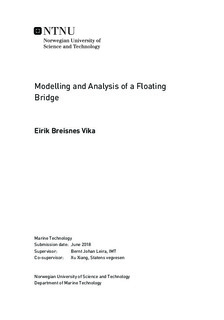Modelling and Analysis of a Floating Bridge
Master thesis
Permanent lenke
http://hdl.handle.net/11250/2564491Utgivelsesdato
2018Metadata
Vis full innførselSamlinger
- Institutt for marin teknikk [3431]
Sammendrag
The Norwegian National Public Road Administration is working on a project toimprove the coastal road E39, connecting the cities along the west coast of Norway.Today, this road has seven ferry crossings which are to be replaced by permanentconnections, to a total expected cost of 340 billion NOK.
Several of these fjords are wider and deeper than what existing designs canmanage, such that new technology needs to be developed. For some of the fjordcrossings, floating bridge concepts have been developed and concluded to be feasiblesolutions. For the about 4500 meters wide Bjørnafjorden, south of Bergen, thereare two floating bridge concepts which are in the process of being further assessed.
One of these concepts is a straight bridge, laterally supported by pre-tensionedmooring lines. This concept was modelled in the software SIMO-RIFLEX, wherea static, eigenvalue and dynamic analysis were performed in order to illustratemodelling aspects and calculation procedures. Panel models of the pontoon weremodelled in GeniE and imported into HydroD where hydrodynamic analyses werecarried out in Wadam.
From the eigenvalue analysis, a significant limitation was identified in the eigenvaluecalculation codes in SIMO-RIFLEX, as the catenary mooring lines were notproperly accounted for. Therefore, a second model was made where the mooringsystem was replaced by a linearised implementation. For this model, the eigenperiods and mode shapes were coinciding well with those obtained by the NPRA.The first 30 eigen periods were differing with a mean value of 3.9 % when only theinfinite-frequency added mass matrix was considered. By updating the added massfor a selected set of modes, differences of less than about 2 % were found.
The eigenvalue calculations revealed several modes that can be triggered byenvironmental loads. Laterally dominated modes at high periods with negligibledamping, which can be important for the response in slowly varying wind, andlaterally dominated modes close to the peak period for the 100-year wind waves,were identified. Additionally, modes dominated by pontoon motions along thebridge girder close to this period were found, possibly important for the dynamicweak axis bending moments in the high bridge.
From the dynamic analyses in regular waves, response patterns related to theidentified modes were present when the bridge was subjected to waves from differentdirections, respectively. The maximum weak axis bending moment in the bridgegirder for the conditions examined was found in the high bridge for a responsepattern related to the mentioned modes dominated by pontoon motions along thebridge girder. This moment had a magnitude of 9.1E + 05 kNm, where the dynamicmoment only contributed with 15 %. The results from the analyses performed weretherefore seen to give indications on possible room for girder length to girder heightratio optimisation and should be further assessed based on analyses performed forthe actual environmental conditions in the fjord.
